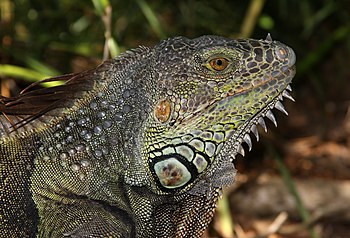There are various freshwater turtle species in the world, but probably none are as well renowned as the red eared sliders. Sliders make an adorable pet, seeking plenty of attention. There are some serious cleanliness measures that should be taken into consideration while nurturing a red eared slider. These measures are as follows:
 |
| A closer look at the head of red-eared slider. (Photo credit: Wikipedia) |
How to distinguish a male and a female red eared slider?
The differences between the male and female red eared slider are fairly distinct, however, they do not become too obvious until the slider reaches sexual maturity. Male red eared sliders reaches sexual maturity in 2 to 5 years, conversely, female red eared sliders reach their sexual maturity in 5 to 7 years. Male sliders can be distinguished from their claws on front feet, which are not present in the females. Furthermore, another trait differentiating male and female slider is their tail. The tail of male slider is longer and thicker. The cloaca in males is located farther from their body with males having somewhat concave plastron.
Tank water and your red eared slider
Red eared sliders spend plenty of time in water, therefore, it is highly recommended that the water they live in is clean. Keeping water clean may sound an ordinary task, however, the reality is slightly different. It is obvious that sliders also defecate in their water. Due to defecation, the tank becomes smelly and cloudy making the cleanliness measures challenging.
In a nut shell, water quality maintenance measures include removing wastes along with instituting colonies of healthy bacteria that will collapse waste products. Ways in which you can do this are as follows:
Measure the quality of water
It is essential to check the levels of ammonia, nitrites and nitrates in the water. Excess of any of these can be irritating and harmful for the turtles. You must purchase test kits for ammonia, nitrites and nitrates from the pet stores. The directions to use them are printed at the back of the kit. High levels of the three requires a complete water change, however, moderate level requires frequent partial water change.
Chlorinated or Dechlorinated Water?
This is subject to conflicting opinions. However, it is suggested to dechlorinate water by using water conditioners. Chlorine can be irritating to your pet, especially to their eyes. If you live in a city where chloramines are used to treat the drinking water, then you must buy a water conditioner that is labeled to remove chlorine, chloramines and ammonia (a by-product of the deactivation of chloramines).
What option of filtration you prefer?
The ideal filter for red eared sliders is the one rated for 2-3 times the size of the sliders tank. There are many filtration levels available in the market such as, biological filtration, chemical filtration and mechanical filtration.
|





